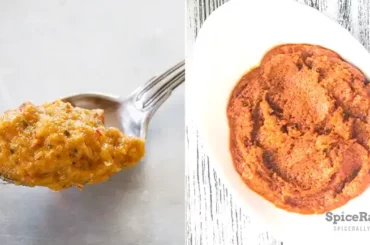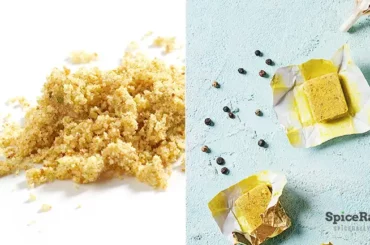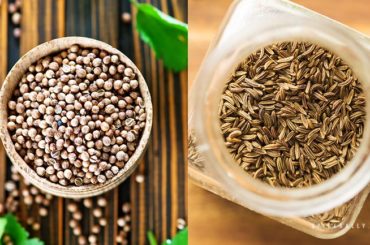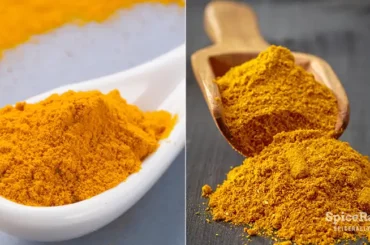Curry powder is one of the staples in Sri Lankan cuisine. But you may find it hard to get from the Western market. Thus, here we got you covered with the best Sri Lankan curry powder substitutes.
You can try the following alternatives instead of Sri Lankan curry powder when the original product is not around:
- Homemade Sri Lankan curry powder
- Indian or Madras curry powder
- Garam Masala
- Curry powder used in Western cuisine
- Tandoori Masala
- Thai curry powder
- Ras el Hanout
- Baharat
- Tikka Masala spice mix
Please read until the end, as we hope to share some essential tips for using these replacements.
9 Ultimate Sri Lankan Curry Powder Substitutes
Sri Lankan curry powder is one of the most complex spice blends made with many aromatic herbs, spices, and other ingredients. To remind you, this spice blend usually comes together with the following:
- Coriander
- Fennel
- Cumin
- Cinnamon
- Fenugreek seeds
- Black pepper
- Cloves
- Black mustard seeds
- Curry leaves
- Pandan leaves
- Cloves
- Green cardamom
- Uncooked rice
You’ll find many variations of Sri Lankan curry powder across its ingrained country. But still, four varieties are prominent out of these types: roasted curry powder, unroasted curry powder, Jaffna curry powder, and chicken curry powder.

However, you may find it challenging to get this if you live in a western country or out of Sri Lanka. Thankfully, several easily accessible substitutes could effectively replace the original blend in such cases. So, let’s see what they are and how they could help you camouflage the absence of traditional Sri Lankan curry powder.
01- Homemade Sri Lankan Curry Powder
A homemade blend of Sri Lankan curry powder is the best possible option to substitute this mixture. Making this is easy, even though it calls for quite a long list of ingredients.
But you can effortlessly find all these spices, herbs, and grains to assemble your fresh batch of curry powder. You can use homemade Sri lankan curry powder with anything that initially calls for the original blend.
Most Sri Lankan households do this rather than buy it from the shops. So, to help you to make your curry powder, we have shared four simple recipes of the four most commonly used Sri lankan curry powder types.
- Simple Homemade Sri Lankan Roasted Curry Powder Recipe!
- Authentic Sri Lankan Unroasted Curry Powder Recipe!
02- Indian Or Madras Curry Powder
The second option in our list is curry powder from the neighboring country of Sri Lanka. You could find many variations of Indian or Madras curry powder, just like the Sri Lankan version.
However, the base of most Indian curry powder variations combines coriander, cumin, and fennel. In addition to these, it also includes a set of similar ingredients, such as:
- Cinnamon
- Fenugreek
- Cardamom
- Cloves
However, Indian curry powder usually includes turmeric powder and red chiles. Therefore, sometimes this alternative can have more heat but less spiciness than our topic leader. Moreover, the ingredients used in Indian curry powder are not as roasted as traditional roasted Sri Lankan curry powder.
Therefore, using this substitute with dishes that call for roasted Sri Lankan curry powder would be better. You can start with a small amount if you are uncertain about substituting. If not, go for a 1:1 ratio and adjust the quantities as per your preference.
03- Garam Masala
Garam Masala is the King of Indian spice blends with a complex flavor profile. The recipe of this mixture also varies depending on the household and region in India.
Yet, due to some similarities in the content, Garam Masala can be a possible substitute in some dishes in place of Sri Lankan curry powder. Most Garam Masala variations contain similar spices, such as:
- Green cardamom
- Cloves
- Fennel
- Coriander
- Cumin
- Black pepper
This alternative does not usually contain rice, sesame seeds, lentils, pandan leaves, or curry leaves. Instead, it might have additional elements like caraway seeds, nutmeg, mace, bay leaves, etc. However, the piquancy comparison of Garam Masala and our topic leader depends upon the ingredients used in each type.
Otherwise, Garam Masala could be generally used instead of roasted or Jaffna curry powder. You can use this option with rice dishes, in some meat or fish curries, soups, or stews. Start with a small quantity and increase the amount depending on your palate.
04- Curry Powder Used In Western Cuisine
Here we talk about the regular curry powder you get in the western market or used in western cuisine. This curry powder type can probably be milder and less spicy since westerners don’t eat spicy food as Asians would do!
Nevertheless, this is one of the most easily-found substitutes since this option can give a similar “curry” vibe comparable to our topic leader. This also shares similar ingredients such as:
- Coriander
- Fenugreek
- Mustard seeds
- Cumin
- Black pepper
- Cloves
The base of this curry powder type is turmeric, making it yellowish and earthier. Also, some variations include celery seeds, ground ginger, and onion powder.
Therefore, you’ll find this option to have a slight flavor difference. So, please stick to milder dishes such as coconut milk-based vegetable curries if using this as a substitute. Use in a 1:1 ratio, more or less as you desire.
05- Tandoori Masala
This is another popular Indian spice blend, which has a lot of similarities in terms of flavor to our topic leader. Accordingly, the Tandoori Masala mixture contains similar ingredients such as:
- Cumin
- Coriander
- Cinnamon
- Green cardamom
- Black pepper
Again, we don’t see the inclusion of a few fundamentals in Sri Lankan curry powder, such as rice, lentils, curry leaves, and pandan leaves. But instead, this option usually contains fenugreek leaves, which gives this blend a distinctive taste.
However, you can effectively swap the original product with tandoori masala when making meat, fish, and seafood dishes. This could be a great addition to shrimp or crab curries! Thus, you can begin with a moderate amount and adjust the quantity as you build up the flavor profile of the particular dish.
06- Thai Curry Powder
This alternative is another exotic blend coming down from Thai cuisine. The base of this curry powder is ground turmeric. Also, it contains galangal, which is a staple in Thai cooking. However, the flavor of Thai curry powder can be comparable to our topic leader since it has main spices like coriander, cumin, and cloves.
Some variations even contain chili powder, ground nutmeg, and cinnamon, making it closer to the Sri Lankan curry powder taste. Therefore, you can choose this option if you can’t find our topic leader in the supermarket’s international spice aisle.
But it would be best to use this alternative in milder curries/ dishes and stick to the one that calls for the original blend as a secondary element. If you feel like the flavor could be exotic, start moderately and then go generously!
07- Ras el Hanout
If you are familiar with Mediterranean cuisine, we bet Ras el Hanout is not alien to you! The good news is that this spice blend is also an excellent substitute for Sri Lankan curry powder.
This is also one of the best spice combinations in the world, made with the standard and some tropical ingredients. Ras el Hanout shares a set of similar elements with our subject leader, such as:
- Cumin
- Coriander
- Cloves
- Black pepper
- Cinnamon
- Cardamom
In this blend, too, you will not find more decadent ingredients like ground lentils or rice. But there could be more exotic elements like cubeb pepper, orris root, ajwain, etc. Therefore, you’ll find more flavor and difference in depth.
Ras el Hanout will make a better substitute for roasted curry powder, Jaffna curry powder, and chicken curry powder than unroasted curry powder. So, you can start with a smaller quantity and adjust the amount you use in meat dishes, marinades, rubs, etc.
08- Baharat
Baharat is another spicy, warm blend coming down from Middle Eastern cuisine. This also might contain familiar and exotic ingredients, just like we mentioned in Ras el Hanout. Nevertheless, it shares similar elements with Sri Lankan curry powder as follows:
- Cardamom
- Cloves
- Coriander
- Cumin
- Cinnamon
- Black pepper
In this option, you’ll also not get ground lentils, sesame seeds, rice, curry leaves, or pandan leaves. But it may have dried mint, allspice, etc. Our topic leader is based on the flavor profile of coriander, cumin, and fennel seeds.
On the other hand, Baharat revolves around cinnamon, black pepper, and cloves. Hence, it is better to substitute this alternative in pinches only with the dishes that call for Sri Lankan curry powder as a secondary element.
This also could be a better flavor replication in place of roasted chicken and Jaffna Sri Lankan curry powder varieties. You can adjust the quantity to your preference when using this option as a substitute.
09- Tikka Masala Spice Mix
If you don’t have Sri Lankan curry powder but got a jar of Tikka Masala spice mix, then you are good to go with some meat and fish curries! This spice blend also descends from Indian cuisine, with some similar elements like:
- Cloves
- Green cardamoms
- Coriander
- Cumin
- Cinnamon
- Black pepper
This can be less spicy than our topic; no lentils, rice, or curry leaves are usually included. However, this spice blend can be hotter than unroasted curry powder. But can give a comparable flavor effect to roasted Jaffna or chicken curry powder mixtures.
Tikka Masala blend is ideal for chicken, fish, mutton, chickpeas, cauliflower, etc. So, you can begin with a small quantity and increase the amount you substitute as you develop the taste.
You Just Discovered The Best Possible Substitutes For Sri Lankan Curry Powder!
The “curry” essence of a dish is not attainable by every spice blend in your spice cabinet. Consequently, it needs a particular set of flavorful spices and aromatic herbs to give the perfect curry vibe, just like Sri Lankan powder does.
However, universal blends like regular curry powder, Garam Masala, and a few other Indian spice blends, along with Ras el Hanout, Baharat, etc., will always come to cover up the taste of the original blend with comparable flavor notes. So, which alternative from our list is your favorite or the one that works best with your palate? Make sure to keep us posted with your feedback!




